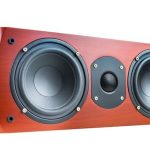Sound comprises a wide frequency spectrum. Due to the wide frequency spectrum of sound, there’re several classifications used to describe certain sound frequency ranges. Among these frequency ranges are mid-bass and midrange. In this article, we’ll discuss mid-bass vs midrange frequencies and speakers in detail.
Mid Bass Frequency
Mid-bass is a sound frequency in the range of 80Hz to 350Hz. Mid-bass is produced by speakers known as mid-bass speakers. It’s a form of a low-frequency sound spectrum. While a subwoofer offers sufficient bass, you may not get accurate mid-bass from a subwoofer. Thus, a mid-bass speaker is ideal to allow for accurate mid-bass.
Midrange Frequency
On the other hand, midrange frequency is a sound frequency in the range of 350 Hz to 5000 Hz. Midrange frequency is produced by midrange speakers. Midrange frequency is perfect for audiophiles who aren’t fans of deep, vibrating sound.
Mid Bass Speakers
As an audiophile or a car music enthusiast, you’ve probably heard about mid-bass speakers. Mid-bass speakers produce higher-frequency bass to add depth to an audio system. They’re especially great when listening to slow songs. Slow songs don’t sound great when listening to them with high-frequency speakers such as tweeters and midrange speakers.
Some car owners assume that combining midrange speakers with subwoofers can deliver the kind of sound that mid-bass speakers produce. However, such a combination cannot deliver accurate mid-bass frequency like dedicated mid-bass speakers. Mid-bass speakers offer great sound direction. Installing dedicated mid-bass speakers ensures that you’ll get improved sound quality.
Midrange Speakers
If you’re seeking to upgrade your car music system, you’ve probably come across midrange speakers. Midrange speakers are especially great for listening to music with a lot of vocals such as soft voices and soft music genres. If you only have subwoofers, mid-bass speakers, and tweeters, then you won’t enjoy the best of soft music. In that case, you’ll need to add midrange speakers.
However, midrange speakers alone cannot produce higher or lower sound frequencies. Thus, using midrange speakers alone will make your sound system flat. Thus, your best bet should be to use midrange speakers in combination with subwoofers and tweeters. That way, you’ll get crisp sound output regardless of the music genre you’re listening to.
Mid Bass Vs Midrange Speakers- Key Similarities
While midrange and mid-bass speakers are designed to produce a different range of sound frequencies, they have some similarities. Let’s discuss their similarities in detail.
Construction Materials
Both midrange and mid-bass speakers are often made using similar materials. For instance, most of these speakers are made of cone materials such as polypropylene, fiberglass, and carbon fiber. Others are made of polymer resin.
The best cone material for these speakers is one that enhances dampening. Although they may be made of the same material, their design allows for the production of different sound frequencies. Also, they may be made of similar surrounding materials. Most of them feature a rubber surround. Other components made of similar materials include the voice coil, speaker basket, spider, and magnet.
Shape
Another similarity between these speakers is that they often feature the same shape. Most midrange and mid-bass speakers feature a conical shape. The idea behind this shape is to improve the sound quality. Their shape allows for wider sound dispersion.
Sound quality
Both types of speakers offer superb sound quality within their frequency range. The best midrange and mid-bass speakers are designed to produce great sound output with minimum distortion. Just ensure you choose a top-quality midrange or mid-bass speaker for the best sound output.
Mid Bass Vs Midrange Speakers- Key Differences
While these speakers share some similarities, they’re also different in certain ways. Here’re their key differences.
Frequency range
These speakers are different in terms of the frequency range they produce. For instance, mid-bass speakers are specially designed to reproduce low-frequency sound within the frequency range of between 80 to 350 Hz. On the other hand, midrange speakers reproduce middle-frequency sound within the range of 350 to 5000 Hz.
If you prefer high-pitched and loud music, mid-bass speakers are not your best option. Mid-bass speakers are more suitable for listening to soft music. The reason behind this is that their supported frequency range allows for catching low-pitched audio better.
On the other hand, midrange speakers aren’t ideal for reproducing low-pitched sound. If you listen to soft or low-pitched music with midrange speakers, the sound output will sound flat. Midrange speakers are ideal for music with intensive vocals.
Size
Although these speakers are often similar in shape, they’re different in size. Generally, midrange speakers are smaller than mid-bass speakers. The reason behind this is that producing lower frequencies requires the cone to move more air than producing higher frequencies. That’s why mid-bass speakers are generally larger than midrange frequencies.
Also Read: Jeep Wrangler Sound System Ideas
Conclusion
Your audio system can only be completed by investing in the right speakers for your listening needs. When comparing mid-bass vs midrange speakers, it’ll help to learn their similarities and differences. That way, you’ll be able to make a wiser decision by knowing which option suits your listening needs. After going through this article, you can be confident in choosing the right speakers for your car audio system.
Michael Evanchuk is a San Francisco-based sound engineer with 20 years’ experience installing, troubleshooting, and repairing commercial, automotive, and household sound equipment. Evanchuk owns an auto stereo center, where he offers highly competitive car audio installation and repair services. He has written dozens of articles on different sound engineering topics, all of which have been published in leading journals, blogs, and websites.





